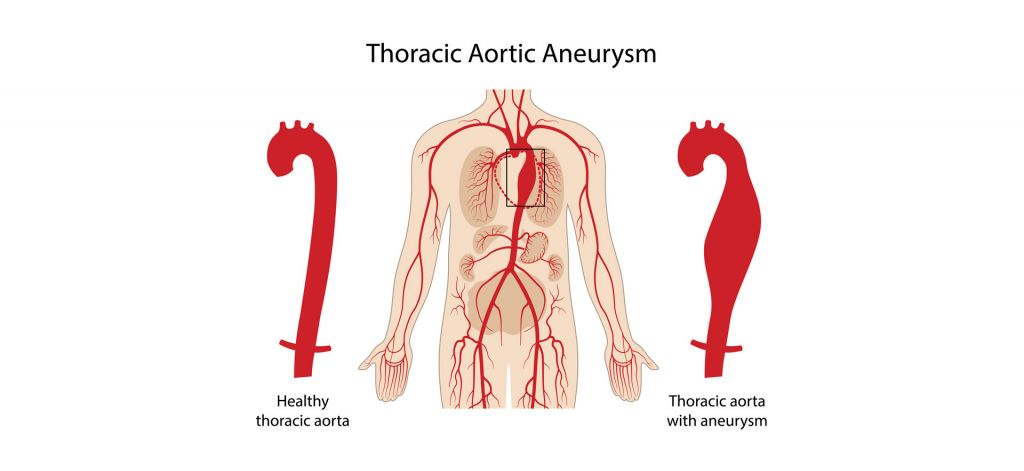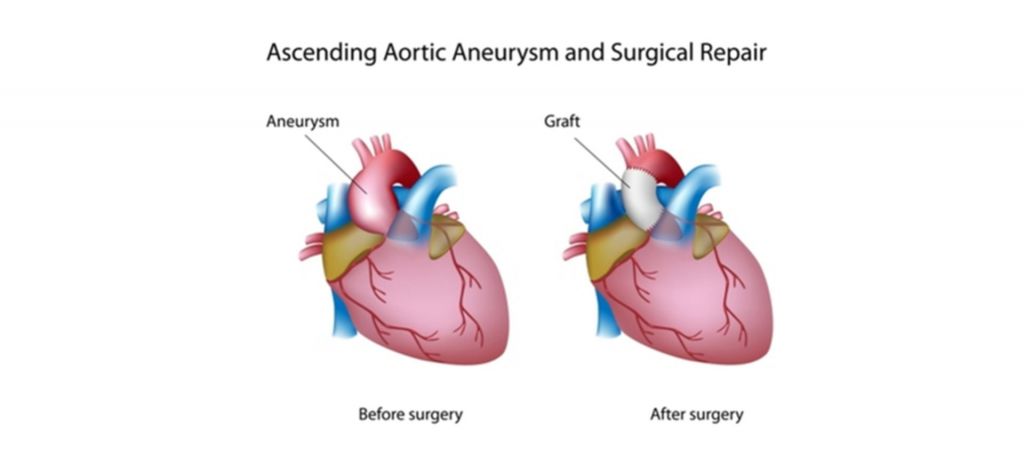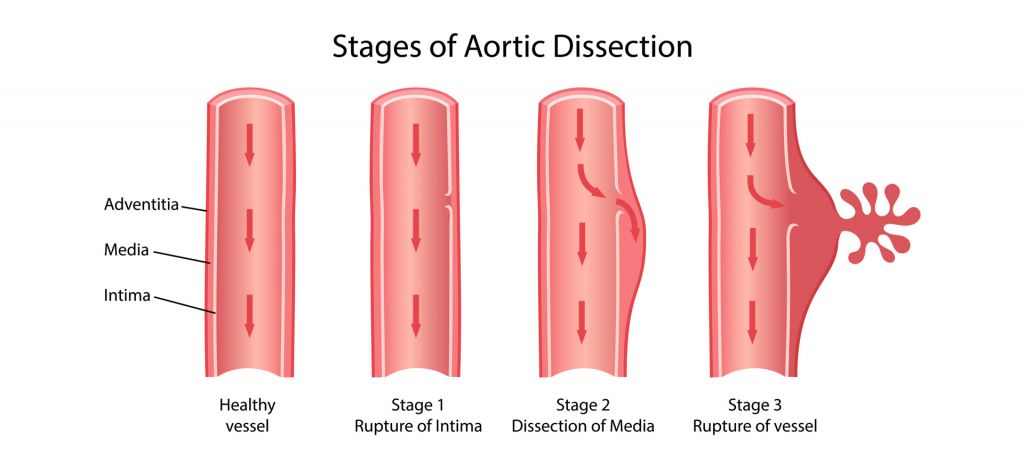DIAGNOSES-OPERATIONS
AORTIC ANEURYSMS AND AORTIC DISSECTIONS
WHAT IS IT?
The aorta is the largest blood vessel in the body and it carries blood from the heart towards the body. When it grows in diameter this is known as an aortic aneurysm. The danger with an aneurysm is that it may rupture and the patient will have a very rapid internal bleed. The second danger is that there will be a tear in the wall of the aorta leading to an aortic dissection whereby the blood flows through the torn layers instead of going to the vital organs.
WHAT CAUSES IT?
The most common cause of aneurysms and dissections is high blood pressure (hypertension). Other factors that contribute include smoking, bicuspid aortic valve (a common anatomical variant), and genetic syndromes such as Marfan, Loeys-Dietz, and Ehlers-Danlos.
SYMPTOMS
Aneurysms usually do not bring on any symptoms until the moment of a catastrophic complication such as rupture or aortic dissection. In the case of such a complication the patient will usually have an intense pain that starts in the chest and goes towards the back and he or she may also feel dizziness and trouble breathing. When one of these complications occur an operation must be done on an emergency basis.
OPERATION
The operation for an aortic aneurysm depends on its location (aortic root, ascending aorta, aortic arch, descending aorta, abdominal aorta, thoracoabdominal aorta). Also there is frequent coexistence of an aortic valve problem which will have to be evaluated for either repair or replacement. Depending on the specific details the operations required may include the David, Yacoub, Bentall or bio-Bentall operation for the aortic root. In general terms the diseased segment of aorta will be removed and replaced with an artificial graft. These operations may be performed with open surgery or, if the anatomy allows, using an endovascular procedure with a catheter from the groin that places a stent in the aneurysm. This method is called TEVAR (thoracic endovascular aneurysm repair) and it allows the patient to have a faster recovery by having the operation without an incision.
Dr. Pattakos uses the cutting-edge techniques taught to him by Professor Joseph Coselli with whom he trained in Houston, Texas. Dr. Coselli holds the record for having performed the largest number of thoracoabdominal aneurysm operations in the history of cardiac surgery and has invented many of the techniques used in modern aneurysm surgery. These techniques reduce the risk of future problems and also improve recovery times by frequently using an endovascular and transcatheter approach that avoids using any incisions.
The aorta is the largest blood vessel in the body and it carries blood from the heart towards the body. When it grows in diameter this is known as an aortic aneurysm. The danger with an aneurysm is that it may rupture and the patient will have a very rapid internal bleed. The second danger is that there will be a tear in the wall of the aorta leading to an aortic dissection whereby the blood flows through the torn layers instead of going to the vital organs.
WHAT CAUSES IT?
The most common cause of aneurysms and dissections is high blood pressure (hypertension). Other factors that contribute include smoking, bicuspid aortic valve (a common anatomical variant), and genetic syndromes such as Marfan, Loeys-Dietz, and Ehlers-Danlos.
SYMPTOMS
Aneurysms usually do not bring on any symptoms until the moment of a catastrophic complication such as rupture or aortic dissection. In the case of such a complication the patient will usually have an intense pain that starts in the chest and goes towards the back and he or she may also feel dizziness and trouble breathing. When one of these complications occur an operation must be done on an emergency basis.
OPERATION
The operation for an aortic aneurysm depends on its location (aortic root, ascending aorta, aortic arch, descending aorta, abdominal aorta, thoracoabdominal aorta). Also there is frequent coexistence of an aortic valve problem which will have to be evaluated for either repair or replacement. Depending on the specific details the operations required may include the David, Yacoub, Bentall or bio-Bentall operation for the aortic root. In general terms the diseased segment of aorta will be removed and replaced with an artificial graft. These operations may be performed with open surgery or, if the anatomy allows, using an endovascular procedure with a catheter from the groin that places a stent in the aneurysm. This method is called TEVAR (thoracic endovascular aneurysm repair) and it allows the patient to have a faster recovery by having the operation without an incision.
Dr. Pattakos uses the cutting-edge techniques taught to him by Professor Joseph Coselli with whom he trained in Houston, Texas. Dr. Coselli holds the record for having performed the largest number of thoracoabdominal aneurysm operations in the history of cardiac surgery and has invented many of the techniques used in modern aneurysm surgery. These techniques reduce the risk of future problems and also improve recovery times by frequently using an endovascular and transcatheter approach that avoids using any incisions.



